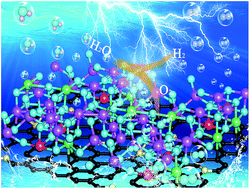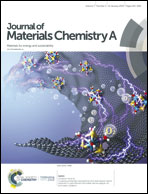Energy level engineering in transition-metal doped spinel-structured nanosheets for efficient overall water splitting†
Abstract
Unraveling the role of transition-metal doping in affecting the native spinel-structured nanosheets' water splitting remains a grand challenge. In this work, a series of spinel-structured nanosheets wrapped hollow nitrogen-doped carbon polyhedrons were constructed, and doped transition-metal domains were deliberately introduced on the surface. Theoretical investigations show that their energy level can be finely tuned via direct transition-metal doping engineering. As a prototype, an Fe-doped NiCo2O4 nanosheets wrapped hollow nitrogen-doped carbon polyhedron (Fe–NiCo2O4@HNCP) exhibits outstanding bifunctional electrocatalytic performances with low overpotentials (η = 270 mV for OER, η = 84 mV for HER), low Tafel slopes (b = 42 mV dec−1 for OER, b = 47 mV dec−1 for HER), and high durability. The enhanced performance is attributed to the synergistic effects of energy level matching for electron transfer, and partial charge delocalization-induced rich active sites for reactant adsorption via thermodynamic and kinetic acceleration. This work may open a new pathway to design highly active and stable transition-metal doped electrocatalysts by manipulated energy levels for efficient overall water splitting.



 Please wait while we load your content...
Please wait while we load your content...